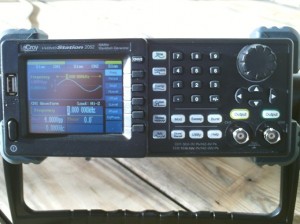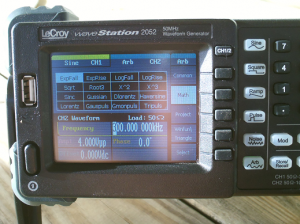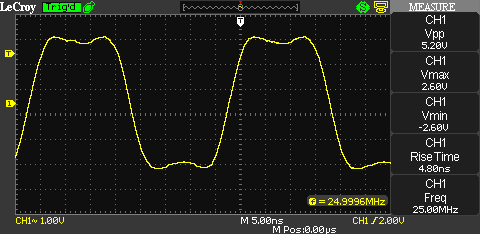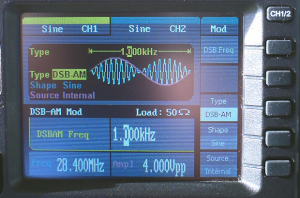The Teledyne LeCroy WaveStation 2052 is a 50 MHz, 2-channel Function/Arbitrary Waveform Generator with 14-bit resolution, 125 MS/s and 16 kpts memory depth. It’s supposed to be a high-quality entry-level arb gen and designed to be a great lab mate for the the WaveAce-series oscilloscopes. T&M Instruments [1] was once again kind enough to supply a demo device for review purposes. Let’s check it out!
As usual with this kind of function generators, the exact characteristics and limitations depend on which channel is being used and what kind of waveform is being generated.
For the whole WaveStation-series, channel 2 is the “better” channel in regards of maximum amplitude. The maximum amplitude of channel 2 is 4 mVpp to 20 Vpp for frequencies ≤ 10 MHz and 4 mVpp – 10 Vpp for frequencies larger than 10 MHz and high impedance. If 50 Ohm impedance is selected, the available amplitude range is cut in half.
The amplitude range of channel 1 is 4 mVpp – 6 Vpp for high impedance and half of that for 50 Ohm impedance. What “high impedance” exactly means in this regard is nowhere to be found in the datasheet. I asked Teledyne LeCroy to provide this info and ideally update the datasheet to reflect this information, as well.
The possible frequency range also depends on the selected waveform. It is 1 μHz – 50 MHz (Sine), 1 μHz – 25 MHz (Square), 500 μHz – 5 MHz (Pulse), 1 μHz – 300 kHz (Triangle / Ramp), and 1 μHz – 5 MHz (Arbitrary Waveforms).
I am not going to cover every tiny detail of the tech specs here. The article is supposed to reflect my personal experience with the WaveStation 2052 and not to just cite the information from the datasheet. If you are interested in the tech specs in greater detail, please consult the datasheet [2].
There are more arbitrary waveforms pre-programmed into the WaveStation than one can count. They are organized in different groups for easier access.
If the supplied arbitrary waveforms aren’t enough, you can build your own. Teledyne LeCroy offers a free software package designed exactly for that purpose [3].
The datasheet promises a rise time of smaller than 12 ns. This number seems pretty conservative compared to the value I measured. My measurement determined a rise time of 4.8 ns.
Built-in modulation capabilities include AM, PM, FM, ASK, FSK and PWM. That’s a few more than most entry-level function generators offer. The user can choose to use an internal modulation source or apply an external modulation signal.
In the modulation menu, I also found a modulation type labelled “DSB-AM.” There is absolutely no explanation about this modulation type in the datasheet. DSB-AM is a common designator for “regular” amplitude modulation (AM) resulting in two sidebands and a carrier. That didn’t make sense as this type of AM is already listed in the menu as “AM.” So what’s up with that?
I wondered if they might mean double-sideband modulation (DSB). There are two kinds of double-sideband modulation. The first being double-sideband reduced carrier (DSB-RC), in which the original carrier stays present but with limited amplitude. The second is double-sideband suppressed carrier (DSB-SC). DSB-SC would definitely be like hitting the jackpot. To my knowledge, this modulation type is not commonly offered in entry-level function generators (nor in pricier generators, for that matter).
To see what this mysterious modulation type is, I connected the WaveStation 2051 to a WaveAce 1002 oscilloscope and set the WaveStation as follows: 10 kHz sinusoidal carrier “DSB-AM” modulated with a 1.25 kHz sinusoidal tone. And this is what it looked like in the frequency domain (bottom trace):
Bingo, jackpot! It’s double-sideband suppressed carrier. We can clearly see the absence of the original 10 kHz carrier and the two sidebands. The sidebands are both exactly 1.25 kHz away from the original carrier. This finding immediately ups the value of the WaveStation 2052 by a lot. Teledyne LeCroy should make sure to mention this bonus point in the manual of the WaveStation and on their webpage.
The DSB modulation can also be used to conduct such called two-tone measurements to determine intermodulation products in linear systems. This feature is very useful for checking the linearity of a HF amplifier for instance. How this works in a practical setup, I will show in a future article.
The menu structure is pretty organized and menu options are where you would expect them to be. Rarely-used featured are hidden a bit deeper in the menu structure than frequently used features. Most functions are self-explanatory, yet there is a great operator’s manual available [4] in case any questions arise.
I do have one suggestion towards the functionality of the rotary encoder (big black dial, top right corner), though. It appears that the rotary encoder also has a tactile switch function. This function is, however, not utilized anywhere. It would improve the user experience significantly if this tactile switch could be used as “select” or “confirm” button when values are being selected using the rotary encoder. At the moment one selects the right value with the rotary encoder and then needs to press a different button to confirm the selection.
If GPIB (IEEE 488) compatibility is needed, a USB to IEEE 488 adapter is available. That way the WaveStation integrates seamlessly into more complex automatic test setups.
A 10 MHz input for an external reference signal is available on the back of the WaveStation. This is a very important feature for me as I synchronize every piece of equipment in my lab to an extremely accurate 10 MHz reference. Make sure to enable the external reference input in the menu, though. The device defaults to the internal reference if an external signal is not found.
The dimensions of the WaveStation are 105 mm x 229 mm x 281 mm (4.1” x 9.0” x 11.1”). Due to its compact size, it fits well even on every moderately crowded workbench. With just 2.6 kg (5.7 lbs), it’s pretty lightweight, as well.
Thanks to its wide power supply range of 100 – 240 VAC and a frequency range of 45 Hz to 440 Hz, this arb gen is excellent for service all around the world. Thanks to the wide frequency range, the function generator can even be used in special 400 Hz mains supply environments such as on board of an aircraft and in special military applications (MIL-STD-704).
The list price of the WaveStation 2052 is $3,450.00. If you are interested in buying one of these, contact T&M Instruments [1] directly. If you are unsure, you can request a demo as well and try the WaveStation out before you make a final decision.
This review is really just scratching the surface of what the WaveStation-series arbitrary waveform generators are capable of. Most features deserve an article on their own. And that’s what I plan on doing in the future. so stay tuned for more.
Links and Sources:
[1] T&M Instruments: http://www.tandm.net/
[2] WaveStation Datasheet, Teledyne LeCroy http://teledynelecroy.com/
[3] WaveStation Software, Teledyne LeCroy http://teledynelecroy.com/
[4] WaveStation Operator’s Manual, Teledyne LeCroy http://teledynelecroy.com/
Westerhold, S. (2012), "Review: Teledyne LeCroy WaveStation 2052 – Arbitrary Waveform Generator". Baltic Lab High Frequency Projects Blog. ISSN (Online): 2751-8140., https://baltic-lab.com/2012/11/review-teledyne-lecroy-wavestation-2052-arbitrary-waveform-generator/, (accessed: April 26, 2024).
Funding:
If you liked this content, please consider contributing. Any help is greatly appreciated.






